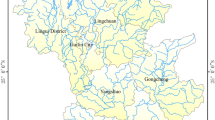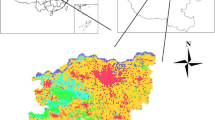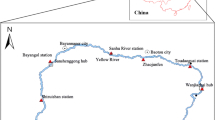Abstract
Risk evaluation for natural disasters is an important part of the emergency management, disaster prevention and mitigation. Because of the complexity and uncertainty of practical evaluation problems, the evaluation information available generally needs depiction of interval gray numbers instead of real numbers. This paper presents an evaluation method with three-parameter interval gray numbers which can deal with dynamic multiple indicators in order to evaluate efficiently the ice-jam disaster risk of Ningxia-Inner Mongolia reaches of the Yellow River in China. The gray range transformation is introduced into the process of model building to eliminate the incomparability of different dimensions. Moreover, model GM(1,1) is used to simulate and predict the development trend of risk vector. As the results show, while the ice-jam disaster risk of Ningxia-Inner Mongolia reaches of the Yellow River reveals certain wave characteristics, the overall trend remains smooth. The risk degree of ice-jam disaster with Bayangol and Toudaoguai is expected to decrease in the years between 2013 and 2015, while that with Sanhu River tends to increase.



Similar content being viewed by others
References
Aleotti P, Chowdhury R (1999) Landslide hazard assessment: summary review and new perspectives. Bull Eng Geol Environ 58(1):21–44
Chen YM, Xie HY (2007) Test of the inconsistency problem on Deng’s grey transformation by simulation. Syst Eng Electron 29(8):1285–1287
Chen K, Blong R, Jacobson C (2001) MCE-RISK: integrating multicriteria evaluation and GIS for risk decision-making in natural hazards. Environ Model Softw 16(4):387–397
Chen K, Blong R, Jacobson C (2003) Towards an integrated approach to natural hazards risk assessment using GIS: with reference to bushfires. Environ Manag 31(4):546–560
Dang YG, Liu GF, Wang JP et al (2004) A multiple attribute decision model with weighted grey target. Stat Decis 3:29–30
Dang YG, Liu SF, Liu B (2005) Study on the multi-attribute decision model of grey target based on interval number. Eng Sci China 7(8):31–35
Hsu C, Hong Z (2007) An intelligent typhoon damage prediction system from aerial photographs. Springer, Berlin, pp 747–756
Karimi I, Hullermeier E (2007) Risk assessment system of natural hazards: a new approach based on fuzzy probability. Fuzzy Sets Syst 158(9):987–999
Korkmaz KA (2009) Earthquake disaster risk assessment and evaluation for Turkey. Environ Geol 57(2):307–320
Liu SF, Lin Y (2006) Grey information theory and practical applications. Springer, Berlin
Liu JF, Li J, Liu J (2008) Comprehensive risk evaluation of floods disasters based on GIS/AHP integration—based on Huaihe River Basin. J Nat Dis 17(6):110–114
Liu M, Lo SM, Hu BQ (2009) On the use of fuzzy synthetic evaluation and optimal classification for computing fire risk ranking of buildings. Neural Comput Appl 18(6):643–652
Luo D (2009) Decision-making methods with three-parameter interval grey number. Syst Eng Theory Pract 29(1):124–130
Luo D, Wang X (2012) The multi-attribute grey target decision method for attribute value within three-parameter interval grey number. Appl Math Model 36:1957–1963
Ma YS, Zhang YC, Zhang CS et al (2004) Theory and method of evaluation on geological disaster risk. J Geomech 10(1):7–18
Wang WP (1997) Study on the grey utility theory for grey target decision. J Huazhong Univ Sci Technol 25(3):89–91
Wang ZX, Dang YG, Yang H (2009) Improvements on decision method of grey target. Syst Eng Electron 31(11):2654–2656
Wu J, Li N, Yang H (2008) Risk evaluation of heavy snow disasters using BP artificial neural network: the case of Xilingol in Inner Mongolia. Stoch Environ Res Risk Assess 22(6):719–725
Yoshimatsu H, Abe S (2006) A review of landslide hazards in Japan and assessment of their susceptibility using an analytical hierarchic process (AHP) method. Landslide 3(2):149–158
Zhang JQ, Li N (2007) The quantitative method and application of evaluation and management for main meteorological disaster risk. Beijing Normal University Press, Beijing
Acknowledgments
This paper was supported by National Natural Science Foundation of China under Grant 71271086, 51379078 and 51009065; Philosophy and Social Science Planning Project of Henan Province under Grant 2011GJJ019; Project of Soft Science of Henan Province under Grant 112400450187; and Natural Science Research Planning Project of Education Department of Henan Province under Grant 13A790065.
Author information
Authors and Affiliations
Corresponding author
Attachment: modeling process of gray forecasting model GM(1, 1)
Attachment: modeling process of gray forecasting model GM(1, 1)
Define the risk measure sequence as \(X^{ ( 0 )} { = }\left( {x^{(0)} ( 1 ) , { }x^{(0)} ( 2 ) ,\ldots , { }x^{(0)} (n )} \right)\), where \(x^{(0)} (k) \ge 0,\) \(k = 1,2, \ldots n\); \(X^{(1)}\) is the first-order accumulating generator sequence (1-AGO) of \(X^{(0)}\):\(X^{(1)} = \left( {x^{(1)} (1),x^{(1)} (2), \ldots ,x^{(1)} (n)} \right)\).
Here \(x^{(1)} (k) = \sum_{i = 1}^{k} {x^{(0)} (i)}\), \(k = 1,2, \ldots n\); \(Z^{(1)}\) is the sequence close to the mean generation of \(X^{(1)}\):\(Z^{(1)} = \left( {z^{(1)} (1),z^{(1)} (2), \ldots ,z^{(1)} (n)} \right)\),In which \(z^{(1)} (k) = 0.5\left( {x^{(1)} (k) + x^{(1)} (k - 1)} \right),k = 2,3 \ldots ,n\).
Define
as the base form of GM(1,1).
If \(\hat{a} = (a,b)^{T}\) is the parameter vector of GM(1,1), then the order least square (OLS) of GM(1,1) is
Here \(Y = \left[ {\begin{array}{*{20}c} {x^{(0)} (2)} \\ {x^{(0)} (3)} \\ \vdots \\ {x^{(0)} (n)} \\ \end{array} } \right]\) \(B = \left[ {\begin{array}{*{20}c} { - z^{(1)} (2)} & 1 \\ { - z^{(1)} (3)} & 1 \\ \vdots & \vdots \\ { - z^{(1)} (n)} & 1 \\ \end{array} } \right]\).
Set \(X^{\left( 0 \right)}\) as nonnegative quasi-smooth sequence, and \(X^{ ( 0 )} { = }\left( {x^{(0)} ( 1 ) , { }x^{(0)} ( 2 ) ,\ldots , { }x^{(0)} (n )} \right)\). \(X^{(1)}\) is the 1-AGO sequence of \(X^{(0)}\), and \(Z^{(1)}\) is the sequence close to the mean generation of \(X^{(1)}\), so \([a,b]^{T} = (B^{T} B)^{ - 1} B^{T} Y\), then
is the whitenization equation of GM(1,1).
Set \(\hat{a} = [a,b]^{T} = (B^{T} B)^{ - 1} B^{T} Y\), then the time response sequence of the model GM(1,1) is
Its reduction value is
Rights and permissions
About this article
Cite this article
Luo, D. Risk evaluation of ice-jam disasters using gray systems theory: the case of Ningxia-Inner Mongolia reaches of the Yellow River. Nat Hazards 71, 1419–1431 (2014). https://doi.org/10.1007/s11069-013-0952-z
Received:
Accepted:
Published:
Issue Date:
DOI: https://doi.org/10.1007/s11069-013-0952-z




